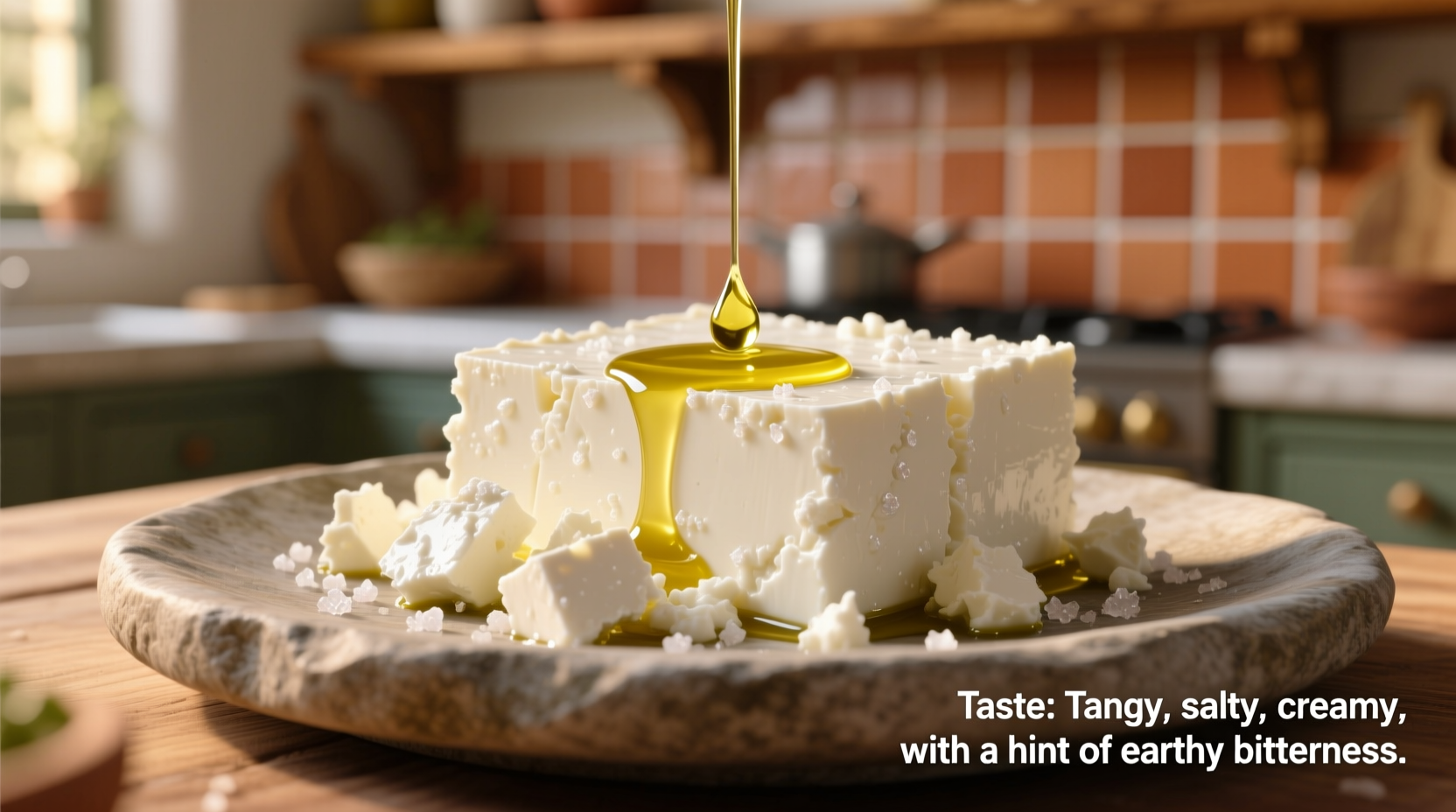Your First Bite: What to Expect from Feta
When you take your first bite of quality feta, your taste buds immediately register its signature saltiness—a direct result of the brine aging process. But this isn't one-dimensional salt. Within seconds, a bright lactic tang emerges, followed by subtle nutty and earthy notes. The texture surprises many newcomers: moist yet crumbly, with a creamy mouthfeel that melts away cleanly. Unlike aged cheeses that coat your palate, feta refreshes rather than overwhelms.
Breaking Down Feta's Sensory Profile
Feta's taste experience unfolds in three distinct phases that create its unique character:
Taste Dimensions
- Saltiness: Ranges from moderate to pronounced depending on brine concentration and aging time
- Acidity: Bright lactic acid notes from fermentation (pH 4.4-4.6)
- Umami: Savory depth from protein breakdown during aging
- Bitterness: Should be minimal in quality feta—excessive bitterness indicates poor production
Texture Characteristics
Feta's texture directly influences flavor release. Properly made feta maintains structural integrity while yielding to pressure. When crumbled, it should feel moist but not wet, with small irregular pieces that hold their shape. The ideal mouthfeel combines creaminess with slight granular resistance—a textural signature that distinguishes authentic feta from imitations.
| Characteristic | Greek Feta (PDO) | Balkan-Style American "Feta"||
|---|---|---|---|
| Milk Source | Minimum 70% sheep, up to 30% goat | Goat or cow milk | Primarily cow milk |
| Salt Level | Moderate, well-integrated | Often overly salty | Variable, frequently bland |
| Acidity | Balanced tang | Sharp, sometimes harsh | Mild, less complex |
| Texture | Creamy yet crumbly | Often rubbery | Soggy or dry |
How Production Affects Feta's Flavor
Feta's taste profile varies significantly based on production methods. Traditional Greek feta protected by PDO (Protected Designation of Origin) follows strict guidelines that create its distinctive character:
Evolution of Traditional Feta Making
- Ancient Greece (8th century BCE): Shepherds preserved cheese in olive oil or wine must
- Roman Era: Introduction of brine preservation techniques
- 19th Century: Standardization of sheep/goat milk ratios in Greek production
- 1996: Greece secures PDO status for "Feta" within European Union
- 2021: Updated PDO regulations refine aging requirements to 2+ months
The specific microflora in Greek mountain pastures contributes unique flavor compounds. According to research published in the International Dairy Journal, Greek feta contains higher concentrations of branched-chain fatty acids that create its characteristic nutty notes compared to imitations (Source).
When Feta Shines: Perfect Pairing Guidance
Feta's flavor profile makes it exceptionally versatile, but certain applications showcase its best qualities:
Ideal Culinary Applications
- Salads: Balances bitter greens like arugula and radicchio
- Grilled vegetables: Melts slightly to create creamy contrast
- Pastries: Traditional in spanakopita where it complements spinach
- Olive oil dishes: The fat carries feta's flavor compounds effectively
Situations Where Feta Falls Short
Feta's strong personality doesn't work in every application. Avoid using it when:
- Melting is required (it becomes greasy rather than creamy)
- Subtle flavors dominate (it will overpower delicate ingredients)
- Extended cooking occurs (loses texture and becomes overly salty)
Common Misconceptions About Feta's Taste
Many people develop inaccurate expectations about feta's flavor. Understanding these misconceptions helps set proper expectations:
- "All feta is extremely salty": Properly made Greek feta has balanced saltiness that enhances rather than dominates
- "Feta tastes like blue cheese": While both are tangy, feta lacks the mold-ripened funk of blue cheeses
- "Good feta should be creamy like brie": Authentic feta maintains crumble—excessive creaminess indicates poor quality

Selecting & Storing for Optimal Flavor
Maximize feta's taste potential with these professional selection and storage techniques:
Selection Checklist
- Look for PDO certification for authentic Greek feta
- Choose blocks stored in brine rather than pre-crumbled
- Check for moist but not soggy texture
- Smell for clean, lactic aroma without ammonia notes
Storage Tips
Preserve feta's delicate flavor balance by:
- Keeping it submerged in original brine
- Transferring to homemade brine (1 cup water + 1 tbsp salt) if needed
- Storing in airtight container away from strong odors
- Using within 2-3 weeks of opening for peak flavor
Frequently Asked Questions
Why does my feta taste bitter?
Bitterness in feta typically indicates improper production or storage. Quality feta should have clean, lactic flavors without bitterness. Causes include using low-quality milk, incorrect aging temperatures, or storing feta in weakened brine that allows spoilage bacteria to develop. Always check expiration dates and ensure feta remains fully submerged in brine.
How does sheep's milk feta differ from cow's milk feta?
Sheep's milk feta (traditional Greek style) has richer flavor with nuttier notes and creamier texture due to higher fat and solids content. Cow's milk feta tends to be milder, less complex, and often more watery. The fatty acid profile differs significantly—sheep's milk contains more branched-chain fatty acids that create distinctive flavor compounds not found in cow's milk versions.
Does feta get stronger with age?
Unlike many cheeses, feta doesn't significantly intensify with extended aging. The PDO standard requires minimum 2 months aging, but most Greek producers age 3-6 months for optimal balance. Beyond 6 months, feta typically becomes excessively salty and loses desirable texture without developing deeper complexity like aged cheddars or parmesans would.
Why does some feta taste metallic?
Metallic flavors usually indicate storage issues. Feta stored in aluminum containers can develop metallic notes through chemical reaction. Even contact with metal utensils during prolonged storage may transfer flavors. Always use non-reactive containers like glass, ceramic, or food-grade plastic for storing feta, and avoid metal serving dishes for extended periods.
Can I reduce feta's saltiness without losing flavor?
Yes, but carefully. Briefly soaking feta in cold water or milk (15-30 minutes) can reduce surface salt without leaching essential flavor compounds. Never soak longer than 1 hour as this removes desirable acidic notes. For cooking applications, add feta at the end rather than during cooking to preserve its delicate flavor balance while controlling salt perception.











 浙公网安备
33010002000092号
浙公网安备
33010002000092号 浙B2-20120091-4
浙B2-20120091-4